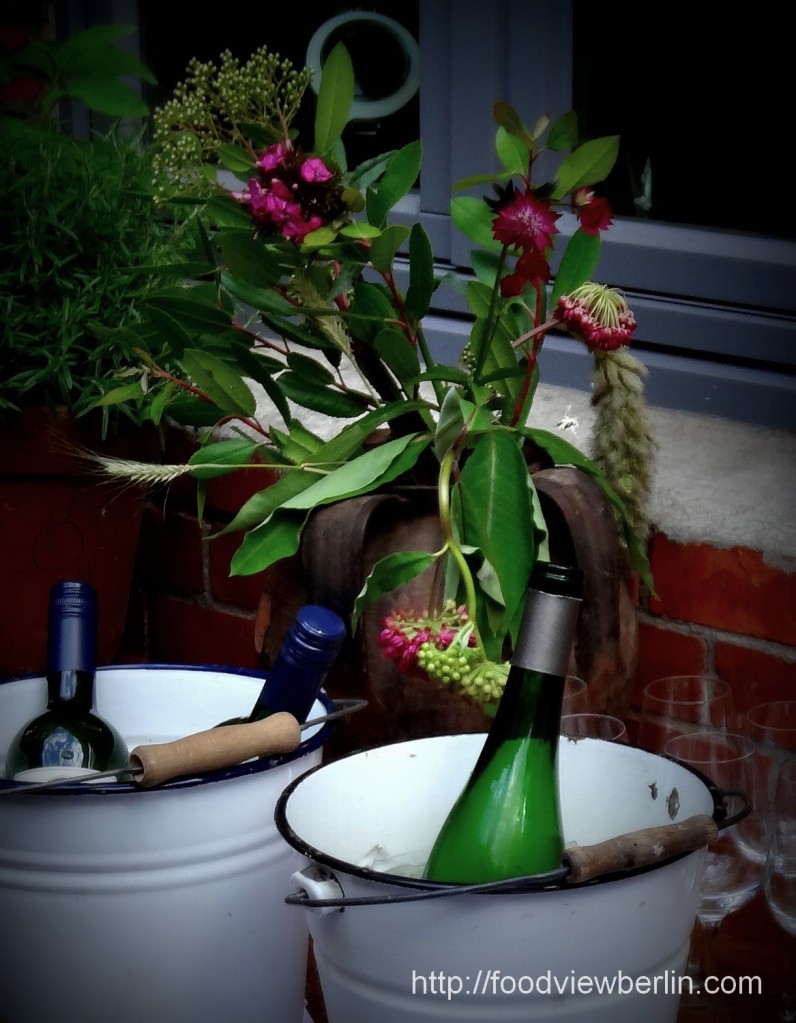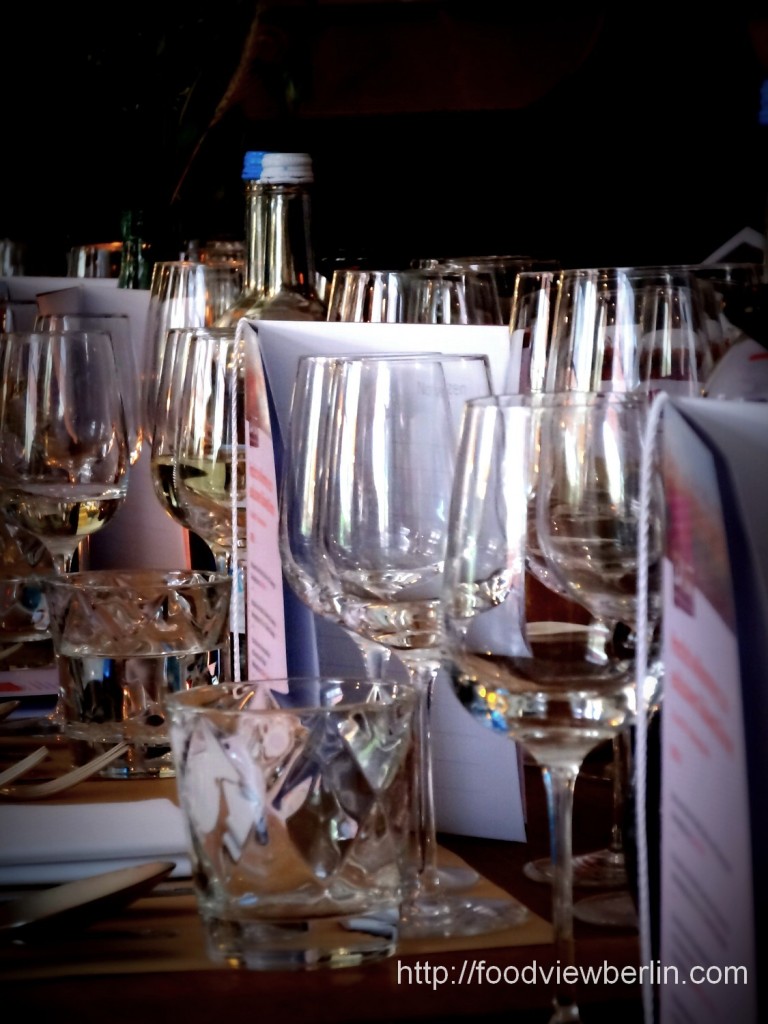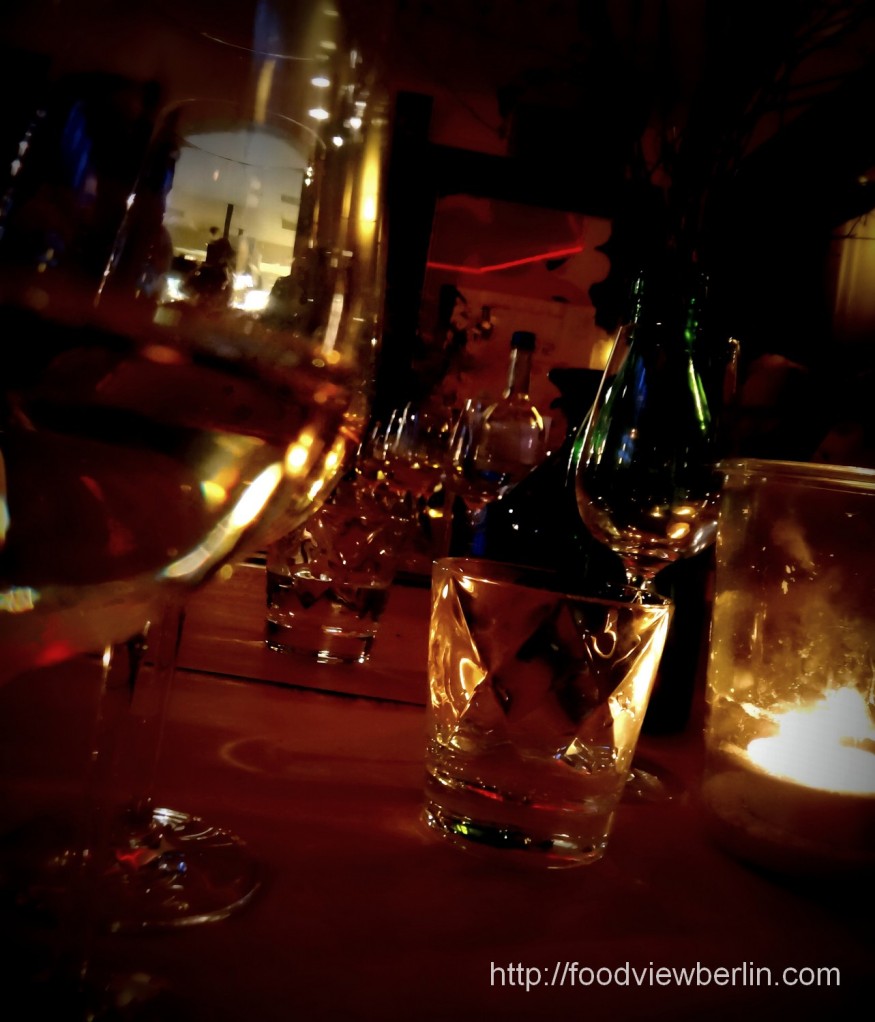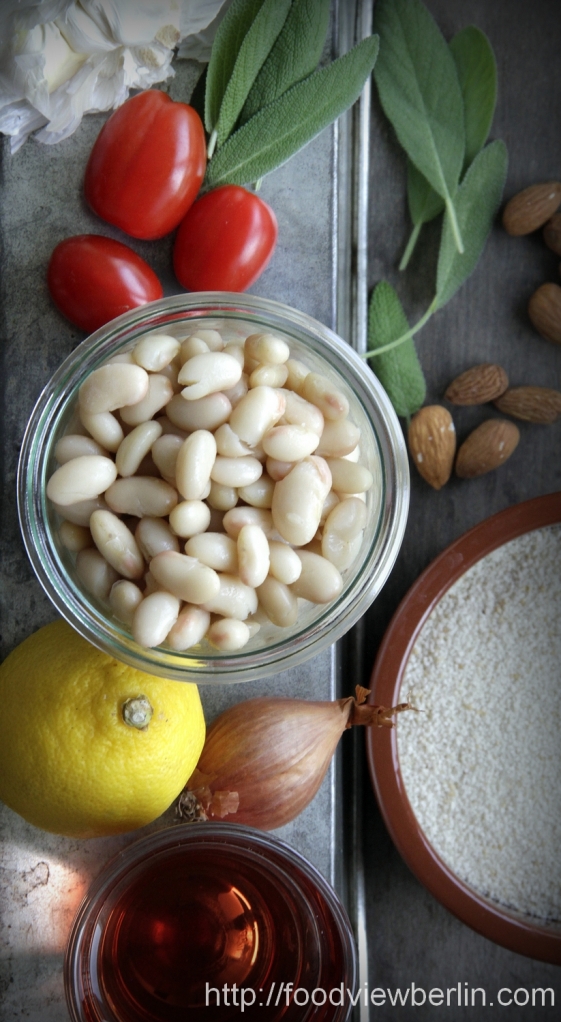It has been a long time ago that I last prepared a cassoulet. On the occasion of a degustation dinner that I had been invited to three weeks ago already, someone reminded me of this major traditional treat from Southern France. It came to my mind to combine the two: writing a bit about the degustation and cooking a vegetarian cassoulet. At summertime it might be less attractive to prepare the latter the traditional way – baking for hours to get seven times a crust. Therefor I invented a lighter version with sherry tomatoes, lemon zest, almonds, and sage – and a (single) nice crust as well.
Of course cassoulet is a dish that calls for a wine from the Midi, doesn’t it. Regarding summer wines, my favorite AOC in this region is Tavel as its wines have a such a powerful yet refreshing attitude. In the course of the wine & dine event Südwest-Dinner (I owe my participation to Maren of r(h)eintopf – thanks a lot again, Maren!), I got some further interesting insight into fine wines from Southwestern France which I would like to mention in this post.
However, I won’t write a full degustation report about the evening for two reasons: First, I do know a few things about terroirs and vinification, but with my faithful devotion to Alsatian Gewürztraminer and Saint Émilion Cru Borgeois (regarding the sort, not the quantity), my general knowledge about wine is kind of restricted. Second, it has been quite an adventure to dive into wine connoisseur’s vocabulary in a language that’s not my native with three different online dictionaries and trilingual wikipedia tabs open on my browser ;-).
But, all this said, I’d really like to share with you some impressions and interesting discoveries – and of course my cassoulet recipe in the end. Here’s some insight to a taste of Southern France on a totally normal Monday night in the middle of Berlin:
Before I get started: the links involved in this post are no sponsored links – so this is no advertorial, just my report about an event I have taken part in as a blogger. Hope you will enjoy it a little.
Some Wines from South-West of France
When I arrived at the degustation location, the hip and hyped Katz Orange, I was delighted for many reasons: the place is known for its sustainability-related food philosophy and it’s located beautifully in a brick backyard environment in central Berlin; a small crowd of people interested in food & wine had already assembled there; and two white wines were offered as an aperitif which is nice on a warm summer’s evening. Good start with a taste of melon and a slightly fizzling texture.
Also a good start as a group that consisted of food writers & journalists, a few bloggers as well, and people of food organizations like for example Slow Food who had all been invited by Sopexa and Interprofession des Vins du Sud-Ouest. We had nice talks with the most friendly and charming vineyard representatives right from the beginning – about wine, of course, and about the fact that wheather had recently been much better in Germany than in France (I could hardly believe…). And of course, the bloggers among us recognized each other immediately – at any event, those people taking pics of the food and the wine labels and the people and everything else are most probably food bloggers, aren’t we ;-).
Once the dinner started, we learned interesting things about the four AOCs/AOPs Saint Mont, Gaillac, Côtes de Gascogne, and Madiran & Pacherenc du Vic-Bilh and about the grapes that originate in the region, grow on complex terroirs and are partly very old and/or cultivated nowhere else. So, how did the wine taste – and what did we have for dinner?
I pick out the wines that I found most interesting – and I start with the last course, the dessert, as it had been accompanied by three white wines, each with a proper level of residual sugar. I love such heavy-weights in flavor not just as companion for sweet treats but also with savory dishes like for example potato gratin or anything that has to do with cheese. Among the three wines that have all been great, I liked especially this one: a 2011 Prélude à l‘Hivernal (Pacherenc du Vic-Bilh) with some kind of toffee touch, rich and full, yet elegant. This wine would be just great with French raw milk cheese as well. By the way: The dessert had been crème brûlée with robinia. Unfortunately it had been liquid despite the first centimeters on top, but the taste of those centimers had been wonderful.
The Prélude reminded me of some Sauternes, and to me, it has been among the most appealing wines of the evening. I take it as a starting point for my little wine review also for another reason: I am very much a fan of buying organic wines and I prefer to support – as a consumer – vineyards that are dedicated to sustainability aspects in some ways. I did a little research on the winegrowers that had been introduced this evening, and the one that interested me the most regarding those criteria had been Plaimont Producteurs, a group of vineyard cooperatives. My Prélude discovery of the evening had been a product of this cooperative as well – it’s not organically grown, but the cooperative as a whole has started to engage in organic vineyard management and started selling organic wines which I think is something worth taking into consideration. And here is some further information about the AOC-AOP: the grapes for sweet wines of Pacherenc du Vic-Bilh are picked by hand late in the season (until December), and the sorts are mainly Arrufiac, Petit Courbu, Petit Manseng, and Gros Manseng – all of them local varieties.
Let’s make a jump to the red wines now. Along with a Pot au feu with plaice and shrimps, we had been introduced to a white and a red wine, the latter being a 2009 Châteu d’Aydie (Madiran) which I liked a lot even though there was much tannic involved (and although it had not been that easy to fully appreciate its facets along with a clear fish soup).
I guess I have to explain my remark about tannin first: Unlike many people that I know I am not part of some the-more-concentrated-and-tannic-the-better fraction which makes me feel a bit awkward sometimes. It’s similar to dark chocolate preferences: admit that you are a milk chocolate addict, and no dark chocolate lover will take you for earnest any more ;-). I sometimes really like milk chocolate nevertheless, and I prefer well-rounded, elegant red wines like from Burgundy or Saint Émilion with tamed tannins, also because my stomach feels much more comfortable with it.
What I loved nevertheless regarding the tannic Châteu d’Aydie was its rustic and kind of edgy character – we later learned that this is due to the totally different terroirs in Madiran. In part, the region is influenced by a dry and hot climate on rocky ground while other parts of it are covered with moist and heavy soil. Many wines are blends made with grapes from both terroirs – isn’t this most interesting? I would be most curious how the Châteu d’Aydie would taste after some further years in the cellar – surely well balanced and still manifold.
Another red wine that I kept in mind had been a 2009 Monastère (Saint Mont) that is distributed by Plaimont as well and tasted of dark chocolate and currant. It came along with the main course (which had been a nice asparagus risotto for me as the only vegetarian at table with some roasted salad and chervil cream). The Saint Mont region is known for old and autochtone grape varieties that are a contribution to bio-diversity – the sort Monastère is made of is called Tannat. The name already indicates that, again, it contains much tannic. I could taste very well the fine quality of vinification, and I can imagine that Tannat is an interesting grape for those of you who are interested in deep, concentrated red wines and want to try something else besides the well-known Cabernet Sauvignon path.
Of course there has been a starter to the whole dinner as well – again with a white wine (and again I got an extra vegetarian treat, a wonderful roasted vegetables roulade with a not so much inspired qinoa salad). The wine had been a 2011 En la Tradition (again Saint Mont), refreshing and with a taste of pineapple. The grape varieties for white wines in Madiran are very much the same like the ones I mentioned regarding Pacherenc du Vic-Bilh, but it’s dry wines that are produced here. Unlike many summer wines this one had a lasting finish but without giving the impression of a strong or heady wine – very charming, indeed.
Many other fine wines of the regions named in the beginning had been served during the dinner – I have focused just on a few to give an impression. All told, it had been a lovely evening in a pleasant atmosphere with a friendly and attentive service, I met interesting people (among them fellow bloggers Ailine of Aicuisine, Aurélie of Französisch kochen and of course Maren) and got new wine inspirations – thanks a lot to everybody who had been involved in the organization of this beautiful degustation dinner. It would have been nice, if some organically grown wines would have been introduced as well – maybe next time? Sustainability topics and organic certifications have grown more important in wine production, and I guess there is an audience for this. I have by all means been inspired to do make some further experience – and now it’s time for some simplified, yet delicious summer cassoulet from the south-west!
Vegetarian summer cassoulet with cherry tomatoes, sage, and lemon zest
For two small or one really big serving, prepare the following ingredients. Clean and cut 2 shallots lengthwise into quarters. Chop two cloves of garlic into not too fine slices. Clean and dry some sage leaves as well as two handsful of cherry tomatoes (don’t chop either of them). Cut 150 g smoked tofu into quarters. Rasp off the lemon zest of ½ lemon (organic). Roughly chop a few almonds. Drain about 250 g (drained weight) white beans, either from a can or cooked from scratch (if you do the latter: to get 250 g cooked beans you will need to soak approximately 80 g overnight and cook for about 1 hour without salt, but with a bouquet garni in the boiling water).
Preheat the oven to 190 °C. In a pan that can later be put to the oven as well, heat some olive oil and roast the smoked tofu. After two minutes, add shallots and clove. Let take a little colour and take off the pan. Add a bit more oil and roast half of the sage leaves. Take off the pan and mix with tofu, garlic and shallots. Put the beans in the pan and roast, deglaze with 50 ml rosé wine (iron pans can react a little bit with the acid – you might be better off with cast iron). Add the tofu mixture again, salt and pepper to taste and place the tomatoes among the beans and tofu quarters. In another pan, melt 1 tablespoon of butter. Mix 3 tablespoons of breadcrumb with lemon zest and the almonds and add on top of the bean dish, carefully sprinkle the melted butter on the bread crumbs.
Put into the oven for about 20-25 minutes. In the meantime, heat some olive oil in the butter pan and roast the rest of the sage leaves. Take the cassoulet off the oven and decorate with the sage. Serve with a fresh salad and some bread. Just a little hint in the end: if you prepare the dish in a pan, like me, you get a result which is a little less moist than a cassoulet that is prepared in a casserole – if you prefer a mor moist version you should use the latter.











What an interesting post – both the degustation’s report and your cassoulet. I had my last cassoulet some years ago during a boat trip along one part of the “Canal du Midi”. It hadn’t been a vegetarian cassoulet and if I wouldn’t be vegetarian I think I could say, it had had a very authentic and delicious taste. But I’m vegetarian…
Therefore – thanks a lot for this version. Sounds delicious and mouthwatering.
Concerning the degustation: Two years ago I had been a juror on the occasion of electing the best organic wines of the year – red, white, rosé and champagne. What an exciting experience. So I think I can share your degustation’s impressions as well.
LikeLike
Thanks a lot you for you interesting comment, Antje! Canal du Midi must be most beautiful – what a wonderful thing to be on a boat and have some cassoulet there… Your participation in the organic wine election must have been very exciting!
LikeLike
This is a beautiful post Claudia! Love your report on the degustation menu and the wines you tried. I know very little about wines from the European region as Australia is quite a big wine producer… we drink a lot of our local varietals here. Your cassoulet looks absolutely delicious! Beautiful flavours, colours and textures. Love the crumb topping and the crispy sage leaves, yum! Thanks for sharing this lovely post! x
LikeLike
Thanks a lot for your beautiful comment, Laura! I got to know some wonderful Australian wines from Barossa Valley, and I would love to know more about the local varieties in Down Under.
LikeLike
We used to go to many tastings years ago. You are right, the language is a world of its own…
I know the edgy Madiran very well and like it a lot, too! 🙂 And the cassoulet, a dream that will soon find its way in my oven!
LikeLike
Great you know Madiran as well – and that you want to try the cassoulet!
I have been to wine tastings so far only as a privat person, and this has been my first invitation as a blogger to a tasting that has been organized for media people. Has been quite exciting for me ;-).
LikeLike
Dear Claudia, it was nice, meeting you in real life – and under such lovely cirmumstances! I love your cassoulet recipe, by the way, and have already put it on my “to cook list”…
LikeLike
Nice to meet you, too, dear Maren :-). Hope you will like the cassoulet!
LikeLike
Will auch mal mittrinken. Da waren genug Gläser – hab’s genau gesehen 😉
LikeLike
Stimmt ;-)!
LikeLike
Pingback: Jurancon - white wines from the foothills of the PyreneesFareham Wine Cellar Blog